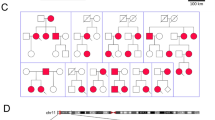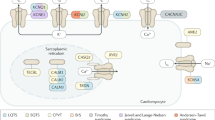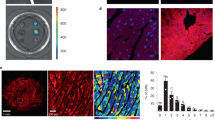Abstract
Deletion of amino-acid residues 1505–1507 (KPQ) in the cardiac SCN5A Na+ channel causes autosomal dominant prolongation of the electrocardiographic QT interval (long-QT syndrome type 3 or LQT3). Excessive prolongation of the action potential at low heart rates predisposes individuals with LQT3 to fatal arrhythmias, typically at rest or during sleep. Here we report that mice heterozygous for a knock-in KPQ-deletion (SCN5AΔ/+) show the essential LQT3 features and spontaneously develop life-threatening polymorphous ventricular arrhythmias. Unexpectedly, sudden accelerations in heart rate or premature beats caused lengthening of the action potential with early afterdepolarization and triggered arrhythmias in Scn5aΔ/+ mice. Adrenergic agonists normalized the response to rate acceleration in vitro and suppressed arrhythmias upon premature stimulation in vivo. These results show the possible risk of sudden heart-rate accelerations. The Scn5aΔ/+ mouse with its predisposition for pacing-induced arrhythmia might be useful for the development of new treatments for the LQT3 syndrome.
This is a preview of subscription content, access via your institution
Access options
Subscribe to this journal
Receive 12 print issues and online access
$209.00 per year
only $17.42 per issue
Buy this article
- Purchase on Springer Link
- Instant access to full article PDF
Prices may be subject to local taxes which are calculated during checkout






Similar content being viewed by others
References
Jiang, C. et al. Two long QT syndrome loci map to chromosomes 3 and 7 with evidence for further heterogeneity. Nature Genet. 8, 141–147 (1994).
Wang, Q. et al. SCN5A mutations associated with an inherited cardiac arrhythmia, long QT syndrome. Cell 80, 805–811 (1995).
Kannel, W.B., Cupples, L.A. & D'Agostino, R.B. Sudden death risk in overt coronary heart disease: the Framingham Study. Am. Heart J. 113, 799–804 (1987).
Willich, S.N. et al. Circadian variation in the incidence of sudden cardiac death in the Framingham Heart Study population. Am. J. Cardiol. 60, 801–806 (1987).
Schwartz, P.J. et al. Prolongation of the QT interval and the sudden infant death syndrome. N. Engl. J. Med. 338, 1709–1714 (1998).
Schwartz, P.J. et al. A molecular link between the sudden infant death syndrome and the long- QT syndrome. N. Engl. J. Med. 343, 262–267 (2000).
Sesti, F. et al. A common polymorphism associated with antibiotic-induced cardiac arrhythmia. Proc. Natl. Acad. Sci. USA 97, 10613–8 (2000).
Napolitano, C. et al. Evidence for a cardiac ion channel mutation underlying drug-induced QT prolongation and life-threatening arrhythmias. J. Cardiovasc. Electrophysiol. 11, 691–696 (2000).
Viskin, S. Long QT syndromes and torsade de pointes. Lancet 354, 1625–1633 (1999).
West, J.W. et al. A cluster of hydrophobic amino acid residues required for fast Na(+)-channel inactivation. Proc. Natl. Acad. Sci. USA 89, 10910–10914 (1992).
Zareba, W. et al. Influence of genotype on the clinical course of the long-QT syndrome. International Long-QT Syndrome Registry Research Group. N. Engl. J. Med. 339, 960–965 (1998).
Schwartz, P.J. et al. Long QT syndrome patients with mutations of the SCN5A and HERG genes have differential responses to Na+ channel blockade and to increases in heart rate. Implications for gene-specific therapy. Circulation 92, 3381–3386 (1995).
Schwartz, P.J. et al. Genotype-phenotype correlation in the long-QT syndrome: Gene-specific triggers for life-threatening arrhythmias. Circulation 103, 89–95 (2001).
Dumaine, R. et al. Multiple mechanisms of Na+ channel-linked long-QT syndrome. Circ. Res. 78, 916–924 (1996).
Nagatomo, T. et al. Temperature dependence of early and late currents in human cardiac wild-type and long Q-T ΔKPQ Na+ channels. Am. J. Physiol. 275, H2016–2024 (1998).
Chandra, R., Starmer, C.F. & Grant, A.O. Multiple effects of KPQ deletion mutation on gating of human cardiac Na+ channels expressed in mammalian cells. Am. J. Physiol. 274, H1643–1654 (1998).
An, R.H., Bangalore, R., Rosero, S.Z. & Kass, R.S. Lidocaine block of LQT–3 mutant human Na+ channels. Circ. Res. 79, 103–108 (1996).
Bennett, P.B., Yazawa, K., Makita, N. & George, A.L. Jr. Molecular mechanism for an inherited cardiac arrhythmia. Nature 376, 683–685 (1995).
Wang, D.W., Yazawa, K., George, A.L., Jr & Bennett, P.B. Characterization of human cardiac Na+ channel mutations in the congenital long QT syndrome. Proc. Natl. Acad. Sci. USA 93, 13200–13205 (1996).
Priori, S.G., Napolitano, C., Cantu, F., Brown, A.M. & Schwartz, P.J. Differential response to Na+ channel blockade, β-adrenergic stimulation, and rapid pacing in a cellular model mimicking the SCN5A and HERG defects present in the long-QT syndrome. Circ. Res. 78, 1009–1015 (1996).
Shimizu, W. & Antzelevitch, C. Differential effects of β-adrenergic agonists and antagonists in LQT1, LQT2 and LQT3 models of the long QT syndrome. J. Am. Coll. Cardiol. 35, 778–786 (2000).
Clancy, C.E. & Rudy, Y. Linking a genetic defect to its cellular phenotype in a cardiac arrhythmia. Nature 400, 566–569 (1999).
Antzelevitch, C., Yan, G.X. & Shimizu, W. Transmural dispersion of repolarization and arrhythmogenicity: The Brugada syndrome versus the long QT syndrome. J. Electrocardiol. 32, 158–165 (1999).
Davies, M.P. et al. Developmental changes in ionic channel activity in the embryonic murine heart. Circ. Res. 78, 15–25 (1996).
Moss, A.J. et al. ECG T-wave patterns in genetically distinct forms of the hereditary long QT syndrome. Circulation 92, 2929–2934 (1995).
Bezzina, C.R., Rook, M.B. & Wilde, A.A. Cardiac Na+ channel and inherited arrhythmia syndromes. Cardiovasc. Res. 49, 257–271 (2001).
Shimizu, W. & Antzelevitch, C. Cellular basis for the ECG features of the LQT1 form of the long-QT syndrome: Effects of β-adrenergic agonists and antagonists and Na+ channel blockers on transmural dispersion of repolarization and torsade de pointes. Circulation 98, 2314–2322 (1998).
Drici, M.D. et al. Involvement of IsK-associated K+ channel in heart rate control of repolarization in a murine engineered model of Jervell and Lange–Nielsen syndrome. Circ. Res. 83, 95–102 (1998).
Casimiro, M.C. et al. Targeted disruption of the Kcnq1 gene produces a mouse model of Jervell and Lange–Nielsen Syndrome. Proc. Natl. Acad. Sci. USA 98, 2526–2531 (2001).
Nerbonne, J.M. Molecular basis of functional voltage-gated K+ channel diversity in the mammalian myocardium. J. Physiol. 525 (Pt 2), 285–298 (2000).
Burashnikov, A. & Antzelevitch, C. Acceleration-induced action potential prolongation and early afterdepolarizations. J. Cardiovasc. Electrophysiol. 9, 934–948 (1998).
Shimizu, W. & Antzelevitch, C. Cellular and ionic basis for T-wave alternans under long-QT conditions. Circulation 99, 1499–1507 (1999).
Zhou, J., Jeron, A., London, B., Han, X. & Koren, G. Characterization of a slowly inactivating outward current in adult mouse ventricular myocytes. Circ. Res. 83, 806–814 (1998).
Boyett, M.R. & Jewell, B.R. Analysis of the effects of changes in rate and rhythm upon electrical activity in the heart. Prog. Biophys. Mol. Biol. 36, 1–52 (1980).
Viswanathan, P.C. & Rudy, Y. Pause induced early afterdepolarizations in the long QT syndrome: a simulation study. Cardiovasc. Res. 42, 530–542 (1999).
Dzhura, I., Wu, Y., Colbran, R.J., Balser, J.R. & Anderson, M.E. Calmodulin kinase determines calcium-dependent facilitation of L-type calcium channels. Nature Cell Biol. 2, 173–177 (2000).
Chen, Q. et al. Genetic basis and molecular mechanism for idiopathic ventricular fibrillation. Nature 392, 293–296 (1998).
Viskin, S. Cardiac pacing in the long QT syndrome: review of available data and practical recommendations. J. Cardiovasc. Electrophysiol. 11, 593–600 (2000).
Carmeliet, P. et al. Impaired myocardial angiogenesis and ischemic cardiomyopathy in mice lacking the vascular endothelial growth factor isoforms VEGF164 and VEGF188. Nature Med. 5, 495–502 (1999).
Sagie, A., Larson, M.G., Goldberg, R.J., Bengtson, J.R. & Levy, D. An improved method for adjusting the QT interval for heart rate (the Framingham Heart Study). Am. J. Cardiol. 70, 797–801 (1992).
Acknowledgements
We thank D. Boon, K. Bijnens, M. De Mol, B. Hermans, S. Jansen, L. Kieckens, A. Vandenhoeck, S.Wyns and Roel Spatjens for assistance.
Author information
Authors and Affiliations
Corresponding author
Rights and permissions
About this article
Cite this article
Nuyens, D., Stengl, M., Dugarmaa, S. et al. Abrupt rate accelerations or premature beats cause life-threatening arrhythmias in mice with long-QT3 syndrome. Nat Med 7, 1021–1027 (2001). https://doi.org/10.1038/nm0901-1021
Received:
Accepted:
Issue Date:
DOI: https://doi.org/10.1038/nm0901-1021
This article is cited by
-
NaV1.5 knockout in iPSCs: a novel approach to study NaV1.5 variants in a human cardiomyocyte environment
Scientific Reports (2021)
-
Alterations in the carnitine cycle in a mouse model of Rett syndrome
Scientific Reports (2017)
-
The effects of ageing and adrenergic challenge on electrocardiographic phenotypes in a murine model of long QT syndrome type 3
Scientific Reports (2017)
-
The Complex QT/RR Relationship in Mice
Scientific Reports (2016)
-
Purkinje Cells as Sources of Arrhythmias in Long QT Syndrome Type 3
Scientific Reports (2015)



